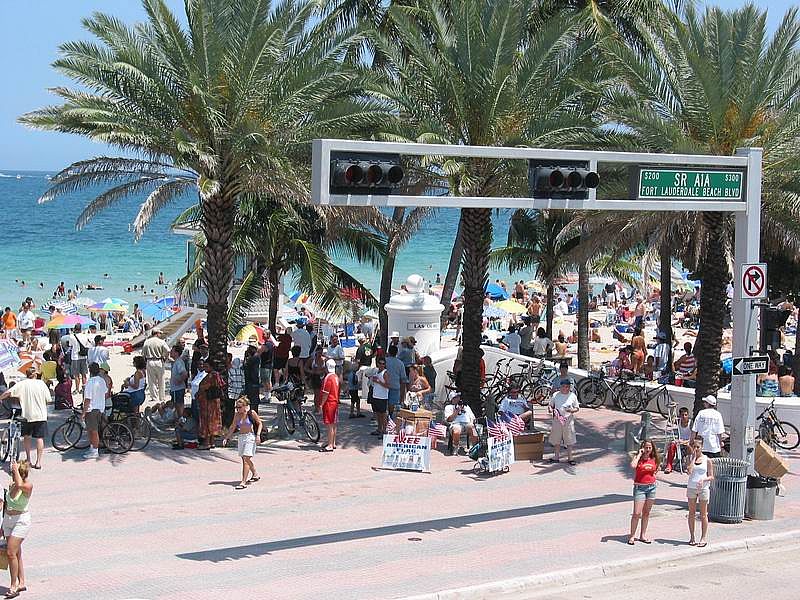Fort Lauderdale , Florida
Fort Lauderdale Beach
 Fort Lauderdale is a beautiful city also called as the "Venice of America,”.
This city is located in Broward County, Florida, United States. Some people
also call this city as "Fort Liquordale" since it is filled
with beaches, bars and clubs and it presents a happening environment.
The 2000 census bureau reported that the city had a total population of
152,397. But the population of the city rapidly increased to 164,578 According
to the 2004 U.S. Census Bureau's Estimates. The Fort Lauderdale constitutes
a little portion of south Florida metropolitan area.
Fort Lauderdale is a beautiful city also called as the "Venice of America,”.
This city is located in Broward County, Florida, United States. Some people
also call this city as "Fort Liquordale" since it is filled
with beaches, bars and clubs and it presents a happening environment.
The 2000 census bureau reported that the city had a total population of
152,397. But the population of the city rapidly increased to 164,578 According
to the 2004 U.S. Census Bureau's Estimates. The Fort Lauderdale constitutes
a little portion of south Florida metropolitan area.
Geography
Fort Lauderdale is placed at 26°08'09?N, 80°08'31?W (26.135763, -80.141810) GR1.
United States Census Bureau gave a report that the city has a total area of 93.3 km² (36.0 mi²). 82.2 km² (31.7 mi²) of the city has land and 11.1 km² (4.3 mi²) of the city has water. The total area is 11.91% water. Fort Lauderdale is called the Venice of America due to the network of canals, and is an especially popular destination for fishing and yachting.
The city of Fort Lauderdale precincts the following boroughs on its outside borders:
On Its East:
Lauderdale-by-the-Sea
Sea Ranch Lakes
On Its South:
Hollywood
Dania Beach
On Its Southwest:
Davie
On Its West:
Plantation
Lauderhill
Lauderdale Lakes
On Its Northwest:
North Lauderdale
On Its North:
Pompano Beach
The northwestern most section of Fort Lauderdale is separate from the
rest of the city, but the Cypress Creek Canal flows under I-95 so it does
not remain separated.
On Its South Side:
Tamarack
Oakland Park,
this place borders Fort Lauderdale on the west side of its northeastern
portion.
The greater portion
of Fort Lauderdale in the south is bordered, along its north side by Wilton
Manors
History
Seminole Indians were the first inhabitants of the Fort Lauderdale and they arrived during the 18th century. Then in 1838 Tennessee volunteers led by Major William Lauderdale fought the second Seminole war and they raised a new fort on the modern city. The first trading post, post office, bank and town hall of the area was established when, a young Ohioan named Frank Stranahan arrived and built a house there in 1893. The house was constructed near the site of New River Fort and remains as a museum till today. 1911 the city was officially integrated as a town and began as a large agricultural community. The residents at that time raised dairy cows and citrus groves.
The black day of the city was on March 17, 1993, when the most disastrous traffic tragedy happened- an Amtrak passenger train and a loaded gasoline truck collided with each other near the Cypress Creek Road crossing in north Fort Lauderdale, which was prevented from moving due to heavy rush hour traffic. The truck driver and as well as five motorists that were stopped at the crossing were killed. Luckily nobody on the train was seriously injured.Hurricane Wilma also demolished a little of the city of Lauderdale on October 24, 2005.
Economy
Tourism is the flourishing industry in the city. Students flocked near this city during the 1970s, and it was also called as the spring break destination for college students; but then during the 1980s, police have suspected on underage dinking and other prohibited activity and the tourist dollars have been largely redirected toward cruise ships and other nautical recreation. But then now recently, Fort Lauderdale is allowing the spring breakers to vacation in their city, because of the large profit they obtains. West to East along Las Olas Boulevard, from the heart of downtown to the beach, these places are considered to be the most entertaining areas. Broward Center for the Performing Arts is present in the west side of the city and there is an intersection there called as the” ground zero" of Fort Lauderdale Beach, and this is the intersection of Las Olas and A1A. This intersection also houses the site of the "Elbo Room" bar featured in the 1960's film. Because of the large number of tourists in the spring this city is also called as the Spring break Mecca
This city has developed magnificently, especially the Fort Lauderdale skyline, featuring black River House, completed in 2004 the downtown area, around Las Olas Boulevard. It now presents wonderful hotels and high-rise condominium developments. A wide assortment of new boutiques, galleries, and restaurants form the major part of other improvements in this city. Another beautifully built stadium, the Lockhart Stadium, this was built to attract gazebo-sporting events.
Fort Lauderdale-Hollywood International Airport is the major airport in the city and is one of the fastest developing airports in the country. Fort Lauderdale also houses one of the ten largest general aviation airports in the country, Fort Lauderdale Executive Airport. Port Everglades is the largest seaport in the country. Fort Lauderdale has two railroads, and Amtrak provides services to other cities on the Atlantic coast. Connecting Fort Lauderdale to Miami and West Palm Beach, there is a commuter rail called as the Trirail.
Auto Nation USA, Citrix Systems, One Model Place, and National Beverage Corp are some of the largest companies based on the Fort Lauderdale.
Demographics
152,397 people, 68,468 households, and 33,001 families residing in the city according to the census 2001. The density of the population is 1,854.4/km² (4,803.1/mi²). The city contains 80,862 housing units at an average density of 984.0/km² (2,548.5/mi²). The city has a blend of 64.27% White, 28.88% African American, 0.23% Native American, 1.03% Asian, 0.05% Pacific Islander, 1.76% from other races, and 3.79% from two or more races. 9.45% of the population is Hispanic or Latino of any race.
68,468 households are present, out of which 19.6% have children and teenagers who are 18 and below, 32.2% are married couples living together, 11.5% of the population are single females with no husbands, and 51.8% are broken families. 40.3% of all households are made up of individuals and 11.7% of old aged people who are 65 and above. The average household and family sizes are 2.14 and 2.97 respectively.
Children below 18 years form 19.4% of the population, people who belong to the 18 to 24 age category form 22.3% of the population, 32.8% from 25 to 44, 24.8% from 45 to 64, and 15.3% of people are 65 and above. 39 years is considered to be the median age.
$37,887 is calculated to be the median income of the household, and
$46,175 is the median income of the family. Males have a medium income
of $34,478 against $27,230 for females. $27,798 is calculated to be the
per capita income of the city. 17.7% of the population and 13.8% of families
are very poor and are living below the poverty line.












